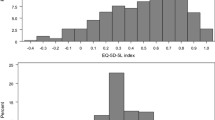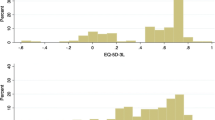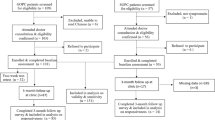Abstract
Purpose
(1) To assess responsiveness of the EQ-5D-5L compared to Oxford hip and knee scores and the SF-12 in osteoarthritis patients undergoing total hip (THR) or knee (TKR) replacement surgery; (2) to compare distribution and anchor-based methods of assessing responsiveness.
Methods
Questionnaires were mailed to consecutive patients following surgeon referral for primary THR or TKR and 1 year post-surgery. We assessed effect size (ES), standardized response mean (SRM), and standard error of measurement (SEM). Minimum important difference (MID) was the mean change in patients reporting somewhat better in hip or knee, health in general, and those who were satisfied with surgery (5-point scales). Responders were compared using MID versus 1 and 2SEM.
Results
The sample of 537 (50% TKR) was composed of 56% female with a mean age of 64 years (SD 10). EQ-5D-5L ES was 1.86 (THR) and 1.19 (TKR) compared to 3.00 and 2.05 for Oxford scores, respectively. MID for the EQ-5D-5L was 0.22 (THR) and 0.20 (TKR) for patients who rated their hip or knee as somewhat better. There was a wide variation in the MID and the percentage of responders, depending on the joint, method of assessment, and the outcome measure. The percent agreement of responder classification using 2SEM vs. MID ranged from 79.6 to 99.6% for the EQ-5D-5L and from 69.4 to 94.8% for the Oxford scores.
Conclusions
Responsiveness of the EQ-5D-5L was acceptable in TKR and THR. Caution should be taken in interpreting responder to TJR based on only one method of assessment.

Similar content being viewed by others
References
Jones, C. A., Beaupre, L. A., Johnston, D. W., & Suarez-Almazor, M. E. (2005). Total joint arthroplasties: Current concepts of patient outcomes after surgery. Clinics in Geriatric Medicine, 21, 527–41.
Franklin, P. D., Lewallen, D., Bozic, K., Hallstrom, B., Jiranek, W., & Ayers, D. C. (2014). Implementation of patient-reported outcome measures in U.S. Total joint replacement registries: rationale, status, and plans. Journal of Bone and Joint Surgery, 96(Suppl 1), 104–109.
Lin, F. J., Samp, J., Munoz, A., Wong, P. S., & Pickard, A. S. (2014). Evaluating change using patient-reported outcome measures in knee replacement: The complementary nature of the EQ-5D index and VAS scores. The European Journal of Health Economics, 15, 489–496.
Ethgen, O., Bruyere, O., Richy, F., Dardennes, C., & Reginster, J. Y. (2004). Health-related quality of life in total hip and total knee arthroplasty. A qualitative and systematic review of the literature. Journal of Bone and Joint Surgery, 86-A, 963–974.
Anakwe, R. E., Jenkins, P. J., & Moran, M. (2011). Predicting dissatisfaction after total hip arthroplasty: A study of 850 patients. The Journal of Arthroplasty, 26, 209–213.
Gandhi, R., Davey, J. R., & Mahomed, N. N. (2008). Predicting patient dissatisfaction following joint replacement surgery. The Journal of Rheumatology, 35, 2415–2418.
Scott, C. E., Howie, C. R., MacDonald, D., & Biant, L. C. (2010). Predicting dissatisfaction following total knee replacement: a prospective study of 1217 patients. The Journal of Bone and Joint Surgery, 92, 1253–1258.
Judge, A., Cooper, C., Williams, S., Dreinhoefer, K., & Dieppe, P. (2010). Patient-reported outcomes one year after primary hip replacement in a European Collaborative Cohort. Arthritis Care & Research, 62, 480–488.
Rolfson, O., Eresian, C. K., Bohm, E., Lubbeke, A., Denissen, G., Dunn, J., et al. (2016). Patient-reported outcome measures in arthroplasty registries. Acta Orthopaedica, 87(Suppl 1), 3–8.
Messick, S. (1989). Validity. In (In R. Linn (Ed.), Educational measurement (pp. 13–103). New York: Macmillan Publishing Company.
SooHoo, N. F., Li, Z., Chenok, K. E., & Bozic, K. J. (2015). Responsiveness of patient reported outcome measures in total joint arthroplasty patients. The Journal of Arthroplasty, 30, 176–191.
Brooks, R. (1996). EuroQol: the current state of play. Health Policy, 37, 53–72.
Ostendorf, M., van Stel, H. F., Buskens, E., Schrijvers, A. J., Marting, L. N., Verbout, A. J., et al. (2004). Patient-reported outcome in total hip replacement. A comparison of five instruments of health status. The Journal of Bone and Joint Surgery, 86, 801–808.
Jenkins, P. J., Clement, N. D., Hamilton, D. F., Gaston, P., Patton, J. T., & Howie, C. R. (2013). Predicting the cost-effectiveness of total hip and knee replacement: a health economic analysis. The Bone & Joint Journal, 95-B, 115–121.
Giesinger, K., Hamilton, D. F., Jost, B., Holzner, B., & Giesinger, J. M. (2014). Comparative responsiveness of outcome measures for total knee arthroplasty. Osteoarthritis Cartilage, 22, 184–189.
Fransen, M., & Edmonds, J. (1999). Reliability and validity of the EuroQol in patients with osteoarthritis of the knee. Rheumatology, 38, 807–813.
Wolfe, F., & Hawley, D. J. (1997). Measurement of the quality of life in rheumatic disorders using the EuroQol. British Journal of Rheumatology, 36, 786–793.
Herdman, M., Gudex, C., Lloyd, A., Janssen, M., Kind, P., Parkin, D., et al. (2011). Development and preliminary testing of the new five-level version of EQ-5D (EQ-5D-5L). Quality of Life Research 20, 1727–1736
Luo, N., Li, M., Chevalier, J., Lloyd, A., & Herdman, M. (2013). A comparison of the scaling properties of the English, Spanish, French, and Chinese EQ-5D descriptive systems. Quality of Life Research, 22, 2237–2243.
Kim, T. H., Jo, M. W., Lee, S. I., Kim, S. H., & Chung, S. M. (2013). Psychometric properties of the EQ-5D-5L in the general population of South Korea. Quality of Life Research, 22, 2245–2253.
Hinz, A., Kohlmann, T., Stobel-Richter, Y., Zenger, M., & Brahler, E. (2014). The quality of life questionnaire EQ-5D-5L: psychometric properties and normative values for the general German population. Quality of Life Research, 23, 443–447.
Kim, S. H., Kim, H. J., Lee, S. I., & Jo, M. W. (2012). Comparing the psychometric properties of the EQ-5D-3L and EQ-5D-5L in cancer patients in Korea. Quality of Life Research, 21, 1065–1073.
Jia, Y. X., Cui, F. Q., Li, L., Zhang, D. L., Zhang, G. M., Wang, F. Z., et al. (2014). Comparison between the EQ-5D-5L and the EQ-5D-3L in patients with hepatitis B. Quality of Life Research, 23, 2355–2363.
Pickard, A. S., De Leon, M. C., Kohlmann, T., Cella, D., & Rosenbloom, S. (2007). Psychometric comparison of the standard EQ-5D to a 5 level version in cancer patients. Medical Care, 45, 259–263.
Scalone, L., Ciampichini, R., Fagiuoli, S., Gardini, I., Fusco, F., Gaeta, L., et al. (2013). Comparing the performance of the standard EQ-5D 3L with the new version EQ-5D 5L in patients with chronic hepatic diseases. Quality of Life Research, 22, 1707–1716.
Janssen, M. F., Pickard, A. S., Golicki, D., Gudex, C., Niewada, M., Scalone, L., et al. (2013). Measurement properties of the EQ-5D-5L compared to the EQ-5D-3L across eight patient groups: a multi-country study. Quality of Life Research, 22, 1717–1727.
Dawson, J., Fitzpatrick, R., Carr, A., & Murray, D. (1996). Questionnaire on the perceptions of patients about total hip replacement. The Bone & Joint Journal, 78, 185–190.
Dawson, J., Fitzpatrick, R., Murray, D., & Carr, A. (1998). Questionnaire on the perceptions of patients about total knee replacement. The Bone & Joint Journal, 80, 63–69.
Murray, D. W., Fitzpatrick, R., Rogers, K., Pandit, H., Beard, D. J., Carr, A. J., et al. (2007). The use of the Oxford hip and knee scores. The Bone & Joint Journal, 89, 1010–1014.
van Hout, B., Janssen, M. F., Feng, Y. S., Kohlmann, T., Busschbach, J., Golicki, D., et al. (2012). Interim scoring for the EQ-5D-5L: mapping the EQ-5D-5L to EQ-5D-3L value sets. Value Health, 15, 708–715.
Ware, J. Jr., Kosinski, M., & Keller, S. D. (1996). A 12-Item Short-Form Health Survey: construction of scales and preliminary tests of reliability and validity. Medical Care, 34, 220–233.
Gonzalez Saenz, dT., Escobar, A., Herrera, C., Garcia, L., Aizpuru, F., & Sarasqueta, C. (2010). Patient expectations and health-related quality of life outcomes following total joint replacement. Value Health, 13, 447–454.
Garbuz, D. S., Xu, M., & Sayre, E. C. (2006). Patients’ outcome after total hip arthroplasty: a comparison between the Western Ontario and McMaster Universities index and the Oxford 12-item hip score. The Journal of Arthroplasty, 21, 998–1004.
McHorney, C. A., & Tarlov, A. R. (1995). Individual-patient monitoring in clinical practice: are available health status surveys adequate? Quality of Life Research, 4, 293–307.
Conner-Spady, B. L., Marshall, D. A., Bohm, E., Dunbar, M. J., Loucks, L., Khudairy, A., A. et al (2015). Reliability and validity of the EQ-5D-5L compared to the EQ-5D-3L in patients with osteoarthritis referred for hip and knee replacement. Quality of Life Research, 24, 1775–1784.
Benson, T., Williams, D. H., & Potts, H. W. (2016). Performance of EQ-5D, howRu and Oxford hip & knee scores in assessing the outcome of hip and knee replacements. BMC Health Services Research, 16, 512.
King, M. T. (2011). A point of minimal important difference (MID): a critique of terminology and methods. Expert Review of Pharmacoeconomics & Outcomes Research, 11, 171–184.
Cohen, J. (1988). Statistical power analysis for the behavioral sciences. Hillsdale: Lawrence Erlbaum Associates.
Revicki, D., Hays, R. D., Cella, D., & Sloan, J. (2008). Recommended methods for determining responsiveness and minimally important differences for patient-reported outcomes. Journal of Clinical Epidemiology, 61, 102–109.
Gulliksen, H. (1950). Theory of mental tests. New York: Wiley
Escobar, A., Quintana, J. M., Bilbao, A., Arostegui, I., Lafuente, I., & Vidaurreta, I. (2007). Responsiveness and clinically important differences for the WOMAC and SF-36 after total knee replacement. Osteoarthritis Cartilage, 15, 273–280.
Quintana, J. M., Escobar, A., Bilbao, A., Arostegui, I., Lafuente, I., & Vidaurreta, I. (2005). Responsiveness and clinically important differences for the WOMAC and SF-36 after hip joint replacement. Osteoarthritis Cartilage, 13, 1076–1083.
Wyrwich, K. W., Tierney, W. M., & Wolinsky, F. D. (1999). Further evidence supporting an SEM-based criterion for identifying meaningful intra-individual changes in health-related quality of life. Journal of Clinical Epidemiology, 52, 861–873.
Lydick, E., & Epstein, R. S. (1993). Interpretation of quality of life changes. Quality of Life Research, 2, 221–226.
Norman, G. R., Sridhar, F. G., Guyatt, G. H., & Walter, S. D. (2001). Relation of distribution- and anchor-based approaches in interpretation of changes in health-related quality of life. Medical Care, 39, 1039–1047.
Norman, G. R., Sloan, J. A., & Wyrwich, K. W. (2003). Interpretation of changes in health-related quality of life: the remarkable universality of half a standard deviation. Medical Care, 41, 582–592.
Hays, R. D., Farivar, S. S., & Liu, H. (2005). Approaches and recommendations for estimating minimally important differences for health-related quality of life measures. COPD, 2, 63–67.
Jaeschke, R., Singer, J., & Guyatt, G. H. (1989). Measurement of health status. Ascertaining the minimal clinically important difference. Controlled Clinical Trials, 10, 407–415.
Ramkumar, P. N., Harris, J. D., & Noble, P. C. (2015). Patient-reported outcome measures after total knee arthroplasty: a systematic review. Bone & Joint Research, 4, 120–127.
Escobar, A., Garcia, P. L., Herrera-Espineira, C., Aizpuru, F., & Sarasqueta, C. (2013). Total knee replacement; minimal clinically important differences and responders. Osteoarthritis Cartilage, 21, 2006–2012
Terwee, C. B., Roorda, L. D., Knol, D. L., de Boer, M. R., & de Vet, H. C. (2009). Linking measurement error to minimal important change of patient-reported outcomes. Journal of Clinical Epidemiology, 62, 1062–1067.
Quintana, J. M., Aguirre, U., Barrio, I., Orive, M., Garcia, S., & Escobar, A. (2012). Outcomes after total hip replacement based on patients’ baseline status: what results can be expected? Arthritis Care & Research, 64, 563–572.
Hawker, G. A., Badley, E. M., Borkhoff, C. M., Croxford, R., Davis, A. M., Dunn, S., et al. (2013). Which patients are most likely to benefit from total joint arthroplasty? Arthritis & Rheumatism, 65, 1243–1252.
Haase, E., Kopkow, C., Beyer, F., Lutzner, J., Kirschner, S., Hartmann, A., et al. (2016). Patient-reported outcomes and outcome predictors after primary total hip arthroplasty: results from the Dresden Hip Surgery Registry. Hip International, 26, 73–81.
Berliner, J. L., Brodke, D. J., Chan, V., SooHoo, N. F., & Bozic, K. J. (2016). John Charnley Award: Preoperative patient-reported outcome measures predict clinically meaningful improvement in function after THA. Clinical Orthopaedics and Related Research, 474, 321–329.
Lee, W. C., Kwan, Y. H., Chong, H. C., & Yeo, S. J. (2017). The minimal clinically important difference for Knee Society Clinical Rating System after total knee arthroplasty for primary osteoarthritis. Knee Surgery, Sports Traumatology, Arthroscopy, 25, 3354–3359.
Clement, N. D., MacDonald, D., & Simpson, A. H. (2014). The minimal clinically important difference in the Oxford knee score and Short Form 12 score after total knee arthroplasty. Knee Surgery, Sports Traumatology, Arthroscopy, 22, 1933–1939.
Beard, D. J., Harris, K., Dawson, J., Doll, H., Murray, D. W., Carr, A. J., et al. (2015). Meaningful changes for the Oxford hip and knee scores after joint replacement surgery. Journal of Clinical Epidemiology, 68, 73–79.
Conner-Spady, B., & Suarez-Almazor, M. E. (2003). Variation in the estimation of quality-adjusted life-years by different preference-based instruments. Medical Care, 41, 791–801.
Impellizzeri, F. M., Leunig, M., Preiss, S., Guggi, T., & Mannion, A. F. (2017). The use of the Core Outcome Measures Index (COMI) in patients undergoing total knee replacement. The Knee, 24, 370–372.
Jenny, J. Y., Louis, P., & Diesinger, Y. (2014). High activity arthroplasty score has a lower ceiling effect than standard scores after knee arthroplasty. The Journal of Arthroplasty, 29, 719–721.
Dawson, J., Fitzpatrick, R., Frost, S., Gundle, R., McLardy-Smith, P., & Murray, D. (2001). Evidence for the validity of a patient-based instrument for assessment of outcome after revision hip replacement. The Journal of Bone and Joint Surgery, 83, 1125–1129.
Naylor, J. M., Kamalasena, G., Hayen, A., Harris, I. A., & Adie, S. (2013). Can the Oxford Scores be used to monitor symptomatic progression of patients awaiting knee or hip arthroplasty? The Journal of Arthroplasty, 28, 1454–1458.
Poitras, S., Beaule, P. E., & Dervin, G. F. (2012). Validity of a short-term quality of life questionnaire in patients undergoing joint replacement: the Quality of Recovery-40. The Journal of Arthroplasty, 27, 1604–1608.
Walters, S. J., & Brazier, J. E. (2005). Comparison of the minimally important difference for two health state utility measures: EQ-5D and SF-6D. Quality of Life Research, 14, 1523–1532.
Whitehurst, D. G., & Bryan, S. (2013). Trial-based clinical and economic analyses: the unhelpful quest for conformity. Trials, 14, 421.
Escobar, A., Gonzalez, M., Quintana, J. M., Vrotsou, K., Bilbao, A., Herrera-Espineira, C., et al. (2012). Patient acceptable symptom state and OMERACT-OARSI set of responder criteria in joint replacement. Identification of cut-off values. Osteoarthritis Cartilage, 20, 87–92.
Beaton, D. E., Boers, M., & Wells, G. A. (2002). Many faces of the minimal clinically important difference (MCID): a literature review and directions for future research. Current Opinion in Rheumatology, 14, 109–114.
Acknowledgements
This study was funded by Canadian Institutes of Health Research (CIHR) (Grant #ETG92252) and Alberta Innovates-Health Solutions (Grant # 200700596). We thank the research personnel who were responsible for project management and data collection: Lynda Loucks, Sarah Tran, Allan Hennigar, Ammar Al Khudairy, and Michaela Wallace.
Author information
Authors and Affiliations
Corresponding author
Ethics declarations
Conflict of interest
The first author is a member of the EuroQol Group, a not-for-profit group that develops and distributes instruments that assess and value health.
Informed consent
All persons gave their informed consent prior to inclusion in the study.
Rights and permissions
About this article
Cite this article
Conner-Spady, B.L., Marshall, D.A., Bohm, E. et al. Comparing the validity and responsiveness of the EQ-5D-5L to the Oxford hip and knee scores and SF-12 in osteoarthritis patients 1 year following total joint replacement. Qual Life Res 27, 1311–1322 (2018). https://doi.org/10.1007/s11136-018-1808-5
Accepted:
Published:
Issue Date:
DOI: https://doi.org/10.1007/s11136-018-1808-5




